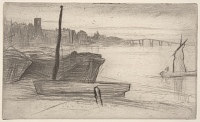Etchings Institutions search term: grolier club
Chelsea Bridge and Church | ||
| Number: | 102 | |
| Date: | 1871 | |
| Medium: | etching and drypoint | |
| Size: | 103 x 170 mm | |
| Signed: | no | |
| Inscribed: | no | |
| Set/Publication: | 'Thames Set', 1871 | |
| No. of States: | 7 | |
| Known impressions: | 56 | |
| Catalogues: | K.95; M.96; T.53; W.85 | |
| Impressions taken from this plate (56) | ||
KEYWORD
TITLE
'Chelsea Bridge and Church' (1871, Ellis and Green). 6
'Chelsea Bridge and Church' (1874, Ralph Thomas, Jr (1840-1876)). 7
'Chelsea Church' (1881, Union League Club). 8
'Chelsea Bridge' (1895, Leipzig). 9
'Chelsea Bridge and Church' is the definitive title, as published in the 'Thames Set' in 1871.
6: A Series of Sixteen Etchings of Scenes on the Thames.
7: Thomas 1874 (cat. no. 53).
8: New York 1881 (cat. nos. 119-20).
9: Leipzig 1895 (cat. no. 815).
DESCRIPTION
SITE
DISCUSSION
10: This tree was actually drawn, not etched.
11: Lochnan 1984 , pp. 170-174.
